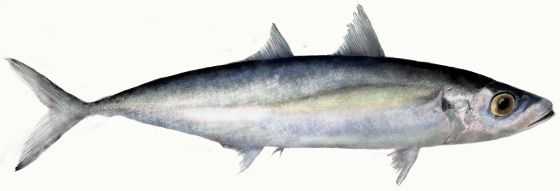Mackerel Scad

Species Details
Decapterus Macarellus
Carangidae
Perciformes
Coastlines, Islands, Offshore
0 - 1 lbs.
8" - 18"
Mackerel Scad (Decapterus macarellus) Fish Description
From the front view, the Mackerel Scad sort of looks rounded but it actually has an elongated body. The whole body is predominantly silver but the dorsal portion of the Mackerel Scad appears to be dark blue. Its dark blue hue appears to be a gradient, slowly turning lighter as it gets to the belly. It also has a bright blue-yellow lateral line that splits between the dark blue portion and the silver-white portion.
Its pectoral fins are dark gray whereas its tail is red to yellow-green. Its tailfin is deeply forked and is slightly frayed on appearance. The Mackerel Scad’s dorsal fin is split into two different sections.
Diet and Size
Mackerel Scads since they themselves are pretty small usually feed on zooplankton. However, if they find themselves on the column, they sometimes feed on small crustaceans like tiny shrimps. Some Mackerel Scads also eat small fishes like herrings and anchovies.
Mackerel Scads are small commercially. They usually are around 10-15 inches, though it highly depends where they are bought. Cultured ones usually go around 8-10 inches. As for weight, they usually don’t reach around 1 lb. Their weight ranges around three-fourths of a pound to 1 lb.
Interesting Facts about the Mackerel Scad
- Mackerel Scads are a common food fish in Hawaii and in the Philippines.
- In Hawaii, they are called Opelu.
- In the Philippines, they are called Galunggong.
- Mackerel Scads are commonly enjoyed fried.
- They can be either plain fried or smoked.
- When plain fried, Filipinos usually enjoy it with some vinegar and garlic. They then also eat it with rice, salted egg, tomatoes, and onions.
- When they’re smoked, they’re known as Tinapa in the Philippines. They’ll normally be called Tinapang Galunggong. In some parts of the Philippines, Filipinos eat smoked Mackerel Scad with champorado – a chocolate rice porridge.
- Some others usually stew it in vinegar and some vegetables such as eggplant and onions.
- Mackerel Scads are enjoyed for their chunky meat. If done right, they end up tasting like chicken.
- The Mackerel Scad, although popular as a gamefish, is more commonly used as bait for bigger fishes such as Giant Trevallies and Blue Spotted Groupers.
- In Japan, they are known as Kusaya which is known to be quite smelly among gourmands.
Fishing Techniques: How to catch a Mackerel Scad
One of the ways to catch a Mackerel Scad is through the Hoop Net method. A common method employed in Hawaii, they get a net that has some vegetable feed and lowers it into the water. As it sinks into the water, it will begin to attract fishes especially those that usually feed on zooplankton. Since zooplankton feeds on algae, the fish that normally feed on zooplankton will be there too. Mackerel Scads are known to eat Zooplankton and attack in schools so expect a big haul.
If you’re planning to do the typical line and bait, some anglers recommend using small shrimps to get them. Cast your line into the water column. Usually, Mackerel Scads head towards the water columns where the shrimp and small fishes are.
Habitat and Distribution
Mackerel Scads are spread all over the world. They are normally found near the surface but can be found in waters that are 131 ft to 656 ft deep of water. As pelagic fish, they usually stay near the surface and nearby islands. Provided, however, that the water must be clear and clean. They were seen swimming through the Western Atlantic in Nova Scotia to Bermuda. For the East Atlantic, Cape Verde and Ascension Island seem to be their spawn points.
They seem to be also pretty prominent in the Pacific waters, reaching as far as Sri Lanka.







